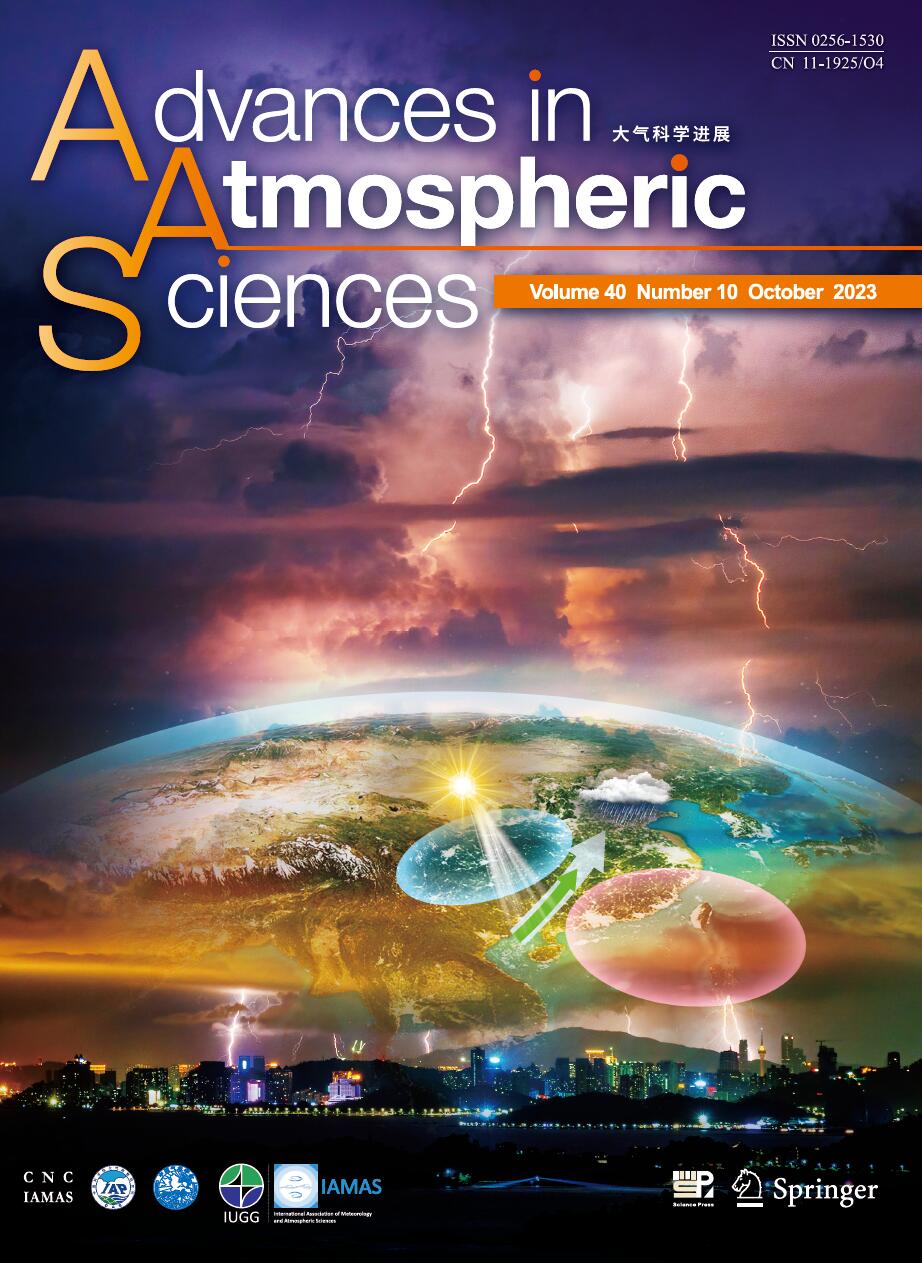| [1] |
HAN Zuoqiang, YAN Zhongwei*, LI Zhen, LIU Weidong, and WANG Yingchun,
2014: Impact of Urbanization on Low-Temperature Precipitation in Beijing during 19602008, ADVANCES IN ATMOSPHERIC SCIENCES, 31, 48-56.
doi: 10.1007/s00376-013-2211-3
|
| [2] |
Chunxiang LI, Guokun DAI, Mu MU, Zhe HAN, Xueying MA, Zhina JIANG, Jiayu ZHENG, Mengbin ZHU,
2023: Influence of Arctic Sea-ice Concentration on Extended-range Forecasting of Cold Events in East Asia, ADVANCES IN ATMOSPHERIC SCIENCES, 40, 2224-2241.
doi: 10.1007/s00376-023-3010-0
|
| [3] |
ZHONG Linhao, FENG Shide, GAO Shouting,
2005: Wind-Driven Ocean Circulation in Shallow Water Lattice Boltzmann Model, ADVANCES IN ATMOSPHERIC SCIENCES, 22, 349-358.
doi: 10.1007/BF02918749
|
| [4] |
Ni Yunqi, Zhang Qin, Lin Wuyin,
1991: Seasonal Characteristics and Interannual Variability of Monthly Scale Low-Frequency Oscillation in a Low-Order Global Spectral Model, ADVANCES IN ATMOSPHERIC SCIENCES, 8, 307-316.
doi: 10.1007/BF02919613
|
| [5] |
FENG Junqiao, HU Dunxin, YU Lejiang,
2012: Low-Frequency Coupled Atmosphere--Ocean Variability in the Southern Indian Ocean, ADVANCES IN ATMOSPHERIC SCIENCES, 29, 544-560.
doi: 10.1007/s00376-011-1096-2
|
| [6] |
FuZuntao, Zhao Qiang, QiaoFangli, Liu Shikuo,
2000: Response of Atmospheric Low-frequency Wave to Oceanic Forcing in the Tropics, ADVANCES IN ATMOSPHERIC SCIENCES, 17, 569-575.
doi: 10.1007/s00376-000-0020-y
|
| [7] |
HE Jinhai, YU Jingjing, SHEN Xinyong,
2007: Impacts of SST and SST Anomalies on Low-Frequency Oscillation in the Tropical Atmosphere, ADVANCES IN ATMOSPHERIC SCIENCES, 24, 377-382.
doi: 10.1007/s00376-007-0377-2
|
| [8] |
Li Maicun,
1987: ON THE LOW-FREQUENCY, PLANETARY-SCALE MOTION IN THE TROPICAL ATMOSPHERE AND OCEANS, ADVANCES IN ATMOSPHERIC SCIENCES, 4, 249-263.
doi: 10.1007/BF02663596
|
| [9] |
Lu Peisheng,
1993: The Propagation of Disturbances Excited by Low-Frequency Oscillations in the Tropics, ADVANCES IN ATMOSPHERIC SCIENCES, 10, 287-295.
doi: 10.1007/BF02658134
|
| [10] |
Lu Keli, Zhu Yongchun,
1994: Seasonal Variation of Stationary and Low-Frequency Rossby Wave Rays, ADVANCES IN ATMOSPHERIC SCIENCES, 11, 427-435.
doi: 10.1007/BF02658163
|
| [11] |
Fu Congbin, Ye Duzheng,
1988: THE TROPICAL VERY LOW-FREQUENCY OSCILLATION ON INTERANNUAL SCALE, ADVANCES IN ATMOSPHERIC SCIENCES, 5, 369-388.
doi: 10.1007/BF02656760
|
| [12] |
Li Guitong, Li Chongyin,
1998: Activities of Low-Frequency Waves in the Tropical Atmosphere and ENSO, ADVANCES IN ATMOSPHERIC SCIENCES, 15, 193-203.
doi: 10.1007/s00376-998-0039-z
|
| [13] |
Chen Longxun, Zhu Congwen, Wang Wen, Zhang Peiqun,
2001: Analysis of the Characteristics of 30-60 Day Low-Frequency Oscillation over Asia during 1998 SCSMEX, ADVANCES IN ATMOSPHERIC SCIENCES, 18, 623-638.
doi: 10.1007/s00376-001-0050-0
|
| [14] |
Zhang Ren, Yu Zhihao,
2000: Low-Frequency CISK-Rossby Wave and Stratospheric QBO in the Tropical Atmosphere, ADVANCES IN ATMOSPHERIC SCIENCES, 17, 311-321.
doi: 10.1007/s00376-000-0012-y
|
| [15] |
Fang ZHOU, Hong-Li REN,
2017: Dynamical Feedback between Synoptic Eddy and Low-Frequency Flow as Simulated by BCC_CSM1.1(m), ADVANCES IN ATMOSPHERIC SCIENCES, 34, 1316-1332.
doi: 10.1007/s00376-017-6318-9
|
| [16] |
Jiapeng MIAO, Tao WANG, Huijun WANG, Yongqi GAO,
2018: Influence of Low-frequency Solar Forcing on the East Asian Winter Monsoon Based on HadCM3 and Observations, ADVANCES IN ATMOSPHERIC SCIENCES, 35, 1205-1215.
doi: 10.1007/s00376-018-7229-0
|
| [17] |
Yan Jinghua, Chen Longxun, Wang Gu,
1988: THE PROPAGATION CHARACTERISTICS OF INTERANNUAL LOW-FREQUENCY OSCILLATIONS IN THE TROPICAL AIR-SEA SYSTEM, ADVANCES IN ATMOSPHERIC SCIENCES, 5, 405-420.
doi: 10.1007/BF02656787
|
| [18] |
Fu Zuntao, Liu Shikuo, Fu Caixia,
1998: Low-Frequency Waves Forced by Large-scale Topography in the Barotropic Model, ADVANCES IN ATMOSPHERIC SCIENCES, 15, 312-320.
doi: 10.1007/s00376-998-0003-y
|
| [19] |
XIA Zhiye, CHEN Hongbin, XU Lisheng, WANG Yongqian,
2015: Extended Range (10-30 Days) Heavy Rain Forecasting Study Based on a Nonlinear Cross-Prediction Error Model, ADVANCES IN ATMOSPHERIC SCIENCES, 32, 1583-1591.
doi: 10.1007/s00376-015-4252-2
|
| [20] |
LI Yuefeng,
2007: Conversion of Kinetic Energy from Synoptic Scale Disturbance to Low-Frequency Fluctuation over the Yangtze River Valley in the Summers of 1997 and 1999, ADVANCES IN ATMOSPHERIC SCIENCES, 24, 591-598.
doi: 10.1007/s00376-007-0591-y
|















 AAS Website
AAS Website 
 AAS WeChat
AAS WeChat 
 DownLoad:
DownLoad: